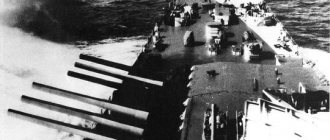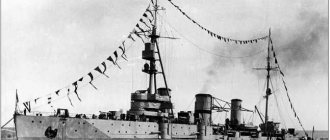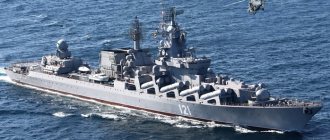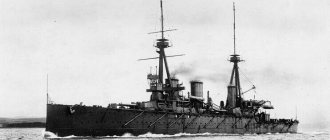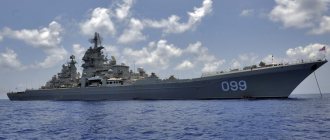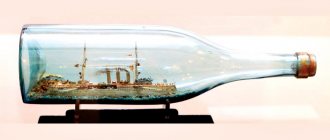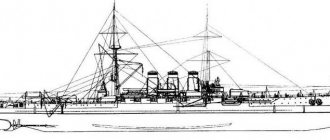The workhorse of the 1st Pacific Squadron. Armored cruiser "Askold". Russia
Home » Literature on the history of the fleet » The workhorse of the 1st Pacific Squadron. Armored cruiser "Askold". Russia
Literature on the history of the fleet
boroda 07/14/2020 1686
17
in Favoritesin Favoritesfrom Favorites 6
On a dark night, without a declaration of war, a sudden attack... this has never happened before and here it is again...
On the night of January 26-27, 1904, Japanese destroyers attacked Russian ships in the outer roadstead of Port Arthur. “Tsesarevich” and “Retvizan” standing in front
and the cruiser
Pallada
received their torpedoes and were out of action for some time.
Askold,
which was closest to the attackers, did not receive a scratch. Only two Japanese torpedoes left a foam trail behind the stern.
Some ships opened fire on the destroyers. But on the flagship Petropavlovsk
(Vice Admiral O.V. Stark), a searchlight beam poked into the sky - a prearranged signal to “cease fire.”
Only at 0.55 did the order come to “Askold”
and
“Novik”
to pursue the already departed Japanese. Then
“Askold”
escorted the
“Tsesarevich”
, to the inner harbor with a detour across the sea, where they again had to drive away the Japanese destroyers.
Togo reported on the disablement of Poltava and Askold
and two more large ships. I'm wrong, it happens.
All this already happened - 9 years ago, in Weihaiwei - the same night attacks of destroyers on Chinese battleships. If only someone had thought of setting up the nets at night, and even the newest ships could have been placed on the edge.
The cruiser "Askold" on the roadstead of Port Arthur in 1904 (in the background is the battleship "Peresvet")
At dawn, Admiral Togo showed up with the main forces of the United Fleet to check on the Russian squadron and assess its overnight losses. While the battleships were preparing to leave and lined up, the cruisers, Bayan,
Askold
and
Novik,
fearlessly rushed towards the Japanese squadron.
The smallest and fastest “Novik”
rushed first into torpedo attack range, followed by “Askold” in a zigzag, dodging the fire
.
A dashing attack by the cruisers covered the deployment of the battleships, and soon the
Askold
received a signal: “Cruisers should not interfere with the battleships.” The cruisers turned back. The battleships forced Togo to leave. The treacherous night attack did not bring the expected results.
Despite the damage received in the battle, the cruiser carried out patrol duty at the entrance to the harbor for another three days and only then stood at the wall of the Marine Plant for repairs.
In just 40 minutes of battle, the cruiser received 6 hits. 4 gunners were killed, 10 sailors were wounded. The greatest damage was from a large-caliber shell that hit the port side at the waterline. It exploded in the cofferdam and destroyed the bulkhead, one of the coal pits was flooded. In addition, the 75 mm gun was damaged, and a hole of almost a square meter appeared in the casing. But the worst thing did not happen - a fragment of this shell passed near the primer with fulminate of mercury loaded into the torpedo tube of a Whitehead mine, without causing detonation and without igniting the explosives. Another shell tore off the barrel of a 152 mm gun on the starboard side. Another damaged the fifth chimney, the rest They damaged the wardroom, the navigation room and knocked down the main topmast. By order of Governor Alekseev, 24 “lower ranks” of “Askold”
were awarded the insignia of the Military Order of St. George.
Behind Askold
After being unharmed in a night attack and a situation with a torpedo, the reputation of a happy ship was established on the squadron.
After repairs, the cruiser went out for reconnaissance on February 5 and 9, together with Bayan
and
Novik
on February 11 exchanged fire with four enemy cruisers. It was one of the most active ships of the squadron.
On February 12, the “battle troika” of Russian cruisers came out to cover the returning destroyers and were the first to meet the armored squadron of Togo, which again approached Port Arthur. 12 Japanese armored ships against three cruisers - the battle lasted about half an hour. The distance was reduced to 30 cables. Speed and maneuver allowed the Russian cruisers to escape under the protection of coastal batteries.
“They showered us with shells, the water was boiling, here and there large columns of water rose, the shells exploded, showering shrapnel all around. Here, one after another, 2 shells fall behind us astern, and one is so close that it pours water on the deck on the poop. At this time, a shot from the stern cannon is heard, as if in response to an arriving gift. The dials chime every minute, showing the distance: 45. 45 1/4. 43... 35; the shells are landing closer and closer, but we give it a go and our car, which has always helped us out, takes us out of danger, the shells are falling either behind the stern, from the sides or ricocheting into the shore. We shot continuously, rushing around the roadstead at full speed.”
"Askold"
fired 257 shells at the enemy without receiving any serious damage; only after the first shot did the barrel of one of the 152 mm guns explode.
After the arrival of Vice Admiral Makarov in Port Arthur, the life of the squadron became even more active. 3 times “Askold”
went out with the squadron, and on March 9 - under the flag of Makarov.
March 9 Russian squadron (flag CO Makarov first on Askold
, and then on
the Petropavlovsk
) for two hours exchanged fire with the main combat forces of the Imperial Japanese Navy (6 battleships, 6 armored cruisers and 6 armored cruisers). However, to no avail.
March 30 “Askold”
“jumped out” into the sea and brought a “catch” - a Chinese junk, and in the evening received the admiral on board. The next day, Makarov died along with the battleship
“Petropavlovsk”
. If Makarov had remained with the headquarters on the “lucky”
“Askold”
, everything could have worked out otherwise.
The Port Arthur squadron went on the defensive. The crew of "Askold"
equipped the first redoubt of the fortress using his own resources - 4-75 mm, searchlight, dynamo.
also helped colleagues from “Victory”
and
“Tsesarevich”
install guns on the Kurgan battery. Two machine guns were handed over to a naval machine gun battery.
On the cruiser itself, they were working on equipment - cleaning the boilers, sorting out the mechanisms. At that time, the miners blew up the masts of the sunken Japanese fire ships in the harbor.
May 5, returning from covering the mine laying of the Amur
,
"Askold"
, without noticing, passed through the minefield of the port. But happiness did not fail.
To support ground forces in the defense of the Kinjous position “Askold”
together with
"Retvizan"
and
"Sevastopol"
they allocated their mine boats.
The boat "Askold"
- with small-caliber cannons and machine guns - was commanded by midshipman F.F. Gerken. While retreating from their positions, the boat was blown up, and the team returned to Port Arthur on foot.
After the loss of Kinjou, from Askold
Two platoons of landing troops went ashore. Two 152 mm guns were ordered to be transferred to
“Retvizan”
- the squadron was preparing to make a breakthrough.
On June 10, the squadron tried to go to sea to break through to Vladivostok, but, having met the Japanese, turned back. Upon their return, already at dusk, the final ships were attacked by destroyers. Askold was the first
and until 4 in the morning the ships fought off Japanese attacks. In the morning, a dozen surfaced torpedoes were collected in the harbor. Reports from our ships speak of several sunk Japanese, but the Japanese themselves modestly admitted only damage to the destroyer
Chidori.
According to the report of the head of the cruiser detachment, “the share of the Askold cruisers”
and
“Novik”
suffered the largest number of attacks, all of them were repelled by sustained aimed fire... According to the testimony of the commanders, all personnel performed their duty with complete composure and zeal.”
While "Askold"
On June 23 and 24, the Japanese 6th destroyer detachment twice tried to attack Russian ships in the harbor.
"Askold"
drove them away and disabled two Japanese non-commissioned officers, seriously wounded, from destroyers
No. 53 and 59.
On July 14,
"Askold"
again went out to chase the destroyers, but behind them were two Italian gifts -
"Nissin" and "Kasuga"
. Here the artillery competition was not in favor of the lucky one. One of the pipes was damaged by shrapnel.
the Bayan mine exploded
Askold
, who was ahead , noticed “his own” and shot)
“Askold”
became the flagship of the cruising detachment.
July 26 (August 8, new style) “Askold”, “Bayan”, “Pallada” and “Novik”
went to Lunwantan Bay to neutralize a group of Japanese ships (cruisers
Akitsushima, Suma and Itsukushima
and other ships) supporting the 3rd Army storming Port Arthur with fire. The shootout was inconclusive.
Finally, on July 28, 1904, Vitgeft decided to lead the squadron to break through to Vladivostok. "Askold"
under the flag of Rear Admiral Reitzenstein, he led a detachment of cruisers, walking in the wake of the battleships. The cruiser had an incomplete set of artillery - two 152 mm, two 75 mm, two 37 mm guns and machine guns were removed from it for the needs of the fortress.
The battle began at 12:30. At 13.09 a 12-inch shell (presumably from the battleship Shikishima)
) ruptured at the base of the first pipe. The pipe was damaged, but survived.
The shrapnel disabled the first boiler. The explosion destroyed the radio room, killing and mortally wounding three people. At 13.12 the second large shell hit the stern and exploded in the chief navigator's cabin. The fire was quickly extinguished. Three minutes later, “Askold”
“Novik”, “Pallada”
and
came out from under fire .
With a skillful maneuver, Reitzenstein brought the cruiser out from under fire. Taking cover behind the battleships, they went in a second column.
The squadrons separated on counter courses, and the ships received a short respite. At 16.05 a semaphore from the squadron commander was received: “In the event of a battle, the head of the cruiser detachment should act at his discretion.”
.
At 16-50 Togo, at the insistence of the English “observer”, tried once again to catch up with the squadron of Rear Admiral V.K Vitgeft. The battle resumed with renewed vigor.
After an hour and a half of battle, V.K Vitgeft was killed. At the flagship "Tsarevich"
The steering wheel jammed, and he began to circulate to the left, followed by the others, the formation was broken.
The cruiser detachment also initially turned left. When they realized that the Tsarevich
was damaged, the cruisers again turned to the right and set a course parallel to the line of battleships.
At this time, the Japanese 1st combat detachment went around the head of the Russian column, and our cruisers were within range of the guns of the leading Japanese battleships. The 5th ( "Chin-Yen", "Matsushima", "Itsukushima" and "Hashidate"
) and 6th (
"Suma", "Ahashi", "Akitsushima", "Izumi"
) combat detachments approached from the west and approached armored cruiser
"Asama"
and destroyers. In total, the logbook recorded 45 enemy ships within sight.
The Russian battleships turned towards Port Arthur. "Askold"
, cruisers and destroyers initially followed their example, but soon Reitzenstein made a decision, supported by the officers, to make a breakthrough, distracting the enemy.
Askold's
foremast : “Be in formation wake,” and then “Cruisers follow me.”
Then this signal was removed. As a result of the confusion, “Pallada”
joined the battleships, and
“Diana”
followed the matelot.
The command vertical with the death of Vitgeft and the inability for Ukhtomsky to raise the admiral’s flag or signals for the squadron on the damaged Peresvet
was violated. According to Reitzenstein's subsequent testimony, he hoped, in the event of a successful breakthrough by the cruisers, to make a way for the battleships. At that time, he was not sure that the squadron had a commander (Ukhtomsky).
At 18.50 “Askold”
opened fire and headed straight for the armored cruiser
Asama
, which was sailing separately.
Soon a fire broke out on the Asama
, as a result of which the Japanese cruiser “increased its speed and began to move away.”
Reitzenstein considered the enemy's weakest point to be the southwest, where the cruisers of the 3rd combat detachment were located. He bypassed the formation of Russian battleships and headed south. It was followed only by Novik
.
The battleships were still heading towards Port Arthur. “The Japanese, apparently, did not expect such a maneuver, and it immediately diverted a fair portion of the fire from the battleships to the Askold
,” Reitzenstein later wrote.
“The armored cruiser Yakumo headed towards Askold, firing at it from 203 mm and 152 mm guns. Behind him, the cruisers of the 6th detachment sparkled with flashes of gunfire, also blocking the path of our ships. To the left and behind, the cruisers of the 3rd detachment of Rear Admiral Dev set off in pursuit. The end ship of the 1st combat detachment "Nissin" and the ships of the 5th detachment also transferred fire to "Askold."
Showered from all sides by shells, the cruiser fought on both sides, bow and stern. High speed, maneuverability and accuracy of return fire preserved the ship. They fought against flooding in the holds, and the gunners were actively working on the deck. The cruiser was heading towards Yakumo
, having prepared the torpedo tubes. But it was not useful, the
Yakumo
, was forced to retreat, one of the “dogs” also fell away, having received damage.
"Askold"
and
"Novik"
flew literally behind the stern of the Japanese.
Then the cruisers repelled the attack of four destroyers, according to the Askoldovites, one of them sank from a direct hit by a 152 mm shell, a fact recorded in the logbook at 19-00. The Japanese, however, traditionally “lose.”
In intense battles, the mechanisms of some 152 mm guns failed; the teeth of the lifting gear were chipped. On the other hand, the supply of shells went according to schedule, although in some cellars it was necessary to lift the shells manually. Despite the losses in the crews, the guns did not stop firing; everyone who could stood up to them, right down to the cook.
The stokers ensured maximum speed when the boilers were pushed to the limit. Some drivers worked without a break for more than 16 hours. “In the end, the drivers had to be pumped out with cold water every 15 minutes. Many walked gropingly - it hurt their eyes afterwards. Some of them went into convulsions from fatigue - we had to spray them with a stream from a hose and thus bring them to their senses
».
After the battle, Reitzenstein wrote in a report to the Main Naval Headquarters about the Askold
and
“Novik”
:
“I sincerely cannot point out how both of these cruisers distinguished themselves: the commanders, officers, mechanics, doctors, lower ranks behaved steadfastly, bravely, calmly, without fuss, smashing the enemy, and fulfilled their duty.”
Only the cruisers of the 6th detachment remained on the Russian route. But as soon as "Askold"
turned sharply towards the cruiser
"Suma"
, which at full speed gave way to the "crazy" Russian cruiser.
At 19.40, an entry appeared in the logbook: “We broke through the enemy cruisers... “Novik”, “Pallada”, “Diana”
invisible behind the darkness."
Dusk fell, the Japanese remained in the distance, occasionally continuing to fire. “Novik”
fell behind after 1-30 due to a malfunction and then decided to break through to Vladivostok on its own.
At dawn on July 29, it became clear that the Japanese cruisers Akashi, Izumi, and Akitsushima
continue to pursue
the Askold
, but the excellent work of the German vehicles and Russian stokers left them behind the horizon. When fully equipped,
the Askold
, of course, could measure their strength with these “babies,” but the long battle also cost it very dearly.
Crew_Askold_1905
One officer and ten sailors were killed in the battle, four officers and 44 sailors were wounded. The guns fired 226 high-explosive 152 mm, 155 steel 75 mm, 65 cast iron 75 mm and 160 47 mm shells at the enemy. Immediately after the breakthrough, four 152-mm guns remained in service; during the night they managed to restore one more. Reinforcements and the deck were destroyed from under the fully operational gun No. 10. The cruiser lost both rangefinder stations, electrical wires were broken in many places, and 10 combat dials were broken. On the starboard side of "Askold"
had four small underwater holes. There were two underwater holes in the left side. In total, the cruiser took in 100 tons of water. The armored deck remained intact. The 1st pipe was broken, the 5th became a third shorter, the rest were riddled with shrapnel. Both stoves in the galley were completely destroyed. The boats and boats resembled a sieve. The ship's engines could provide 15 knots.
Reitzenstein was convinced that "Askold"
would not be able to break through the Korean Strait in this condition. It was decided to enter Shanghai, repair the most significant damage, replenish supplies during the period allowed by international law, and then try to break through to Vladivostok around Japan.
The cruiser 'Askold' in the Shanghai dock after the Battle of the Yellow Sea:
Interned ships at the CER pier in Shanghai
At noon on July 30, 1904 "Askold"
anchored at the mouth of the Wuzung River.
A few days later, Reitzenstein received an order from St. Petersburg to disarm the ship. Tokiwa
was already guarding Shanghai .
On August 11, the Askold
Grozovoy,
which soon followed it, lowered their flags.
The gun locks, torpedo warheads, rifles and some vehicle parts were removed and handed over to the Chinese arsenal; on August 28, the cruiser was taken out of the dock and placed at the pier of the Russian society of the Chinese Eastern Railway, along with the Grozov
Manzhur
, interned at the very beginning of the war . The ships, repainted in a peaceful white color, stood here for more than a year.
Only on October 2, 1905, Shanghai received notification of the ratification of the peace treaty between Russia and Japan. October 11 at Askold
St. Andrew's flag was raised again, and on November 1, under the command of the new commander, Captain 2nd Rank K.V. Stetsenko, the cruiser set sail for Vladivostok.
December 9 “Askold”
enrolled in the Separate detachment of ships for the protection of the Ussuri region.
On May 24 of the following year, the cruiser, which had been in the Baltic Fleet since its construction, was transferred to the Siberian Flotilla, and its crew to the Siberian Fleet Crew. In the summer, Askold
went out to the Amur Bay several times for practical shooting, went around the bays closest to Vladivostok, and spent half of the fall in the dock.
From June 6, 1906, the cruiser was part of the Siberian Flotilla.
The cruiser "Askold" on the roadstead of Vladivostok
Cruiser "Askold"
really became, probably, the happiest ship of the Port Arthur squadron. High quality construction, reliable and powerful vehicles, a brave and trained crew, a decisive and skillful commander - what else is needed for happiness? Just a little luck. And that was enough.
Cruiser 'Askold' wintering in Vladivostok
One of the most active ships in Port Arthur, always in full combat readiness, on patrol, cover, and sorties. During the battle in the Yellow Sea, as if under a spell, he pushed two large armored cruisers in different directions in turn, causing them serious damage, threw a pack of small cruisers off the tail, damaging another of the “dogs.” At the same time, fire was concentrated on him for some time most of the entire Japanese fleet. An armored cruiser with incomplete artillery broke out of the encirclement and almost led the entire squadron behind it.
Source - https://zen.yandex.ru/media/id/5cf01f060d8ac524e68e4579/bronepalubnye-kreisera-schastlivchik-askold-5ea40fa48e079d5083ec3dfc
Background [edit]
After completion of the Pallada
The Imperial Russian Navy issued requirements for three large protected cruisers; three separate ones
were ordered from William Cramp & Sons in Philadelphia, USA, Askold
was ordered from Krupp-Germaniawerft in Kiel, Germany, and
Bogatyr
from the Stettin volcano, also in Germany.
Askold
was the fastest cruiser in the Russian fleet
when it was commissioned Bogatyr
was chosen for further development into a new class of ships, and
Askold
remained as a unique design.
Links[edit]
- Brook, Peter (2000). "Armored Cruiser vs. Armored Cruiser: Ulsan, August 14, 1904." In Preston, Anthony (ed.). Warship 2000–2001
. London: Conway Maritime Press. ISBN 0-85177-791-0. - Robert Gardiner, ed. (1979). All of Conway's World's Warships 1860–1905. Greenwich: Conway Maritime Press. ISBN 0-8317-0302-4.
- Gardiner, Robert; Gray, Randal, ed. (1985). Conway's Fighting Ships of the World: 1906–1921
. Annapolis: Naval Institute Press. ISBN 0-85177-245-5. - McLaughlin, Stephen (1999). "From Ruirik to Ruirik: armored cruisers of Russia." In Preston, Anthony (ed.). Warship 1999–2000
. London: Conway Maritime Press. ISBN 0-85177-724-4. - Watts, Anthony J. (1990). Imperial Russian Navy
. London: arms and armor. ISBN 0-85368-912-1. - Krylov Alexey. (2014). Professor Krylov's fleet: memoirs of a naval architect
. Wakefield: Magnit Publishing House.
Interesting Facts
| : Incorrect or missing image | Check for compliance with encyclopedic criteria. Perhaps the content of this article or section is an arbitrary set of loosely related facts, instructions, a catalog or insignificant news information. Please improve it in accordance with the rules for writing articles. The talk page may have more details. |
- The crew of the cruiser "Askold" and the cruiser itself are one of the key characters in Valentin Pikul's novel "From the Dead End".
- During the Russo-Japanese War of 1904-1905, the future Supreme Ruler of the Russian state, Admiral Kolchak, served on the cruiser.
- On the night of August 20-21, 1916, an explosion occurred in the ship's artillery magazine. The command blamed the cruiser's sailors for the incident, who were previously considered “unreliable,” although direct evidence of the crew’s involvement was never found. After a quick trial and investigation, four Askoldovites - Zakharov, Beshentsev, Shestakov and Biryukov - were sentenced to death. The sailors were shot on September 15 at Fort Malbusque. More than a hundred people from the crew of the “seditious” cruiser were exiled to floating prisons and penal battalions. After the revolution, many sailors accused the ship's officers of having staged a provocation in order to identify and eliminate the “Bolshevik underground.”
Design
Housing and architecture
The cruiser's hull was assembled using a checkered (bracket) system. The hull was divided by waterproof bulkheads into 13 compartments.
Booking
The armored deck was the main protection of the ships. It was called carapace, as its shape resembled the body of a turtle. The armor deck consisted of two layers of plates: the lower one made of shipbuilding steel 10 or 15 mm thick and the upper one made of alloyed nickel armor 30 and 60 mm thick.
The horizontal part of the armor deck had a thickness of 40 (10+30), bevels of 75 (15+60) or 100 (10+30+60) mm. The bases of the chimneys and ammunition supply elevators were protected from the armor to the living deck by 40-mm vertical armor plates. The descent into the tiller compartment was protected by an inclined 100-mm armored coaming. The surface torpedo tubes were covered with vertical 60 mm armor, 30 mm below and above.
Armament
The artillery armament consisted only of “quick-firing” guns: twelve 152 mm Kane cartridge guns with a barrel length of 45 calibers in deck and casemate installations, twelve 75 mm Kane guns with a barrel length of 50 calibers and eight single-barreled 47 mm Hotchkiss guns.
In addition, the artillery armament included two 63.5-mm landing guns of the Baranovsky system on wheeled carriages, designed to reinforce the naval landing.
Commanders
- 1899-1904. -Reitzenstein, Nikolai Karlovich
- 1904-1905. -Grammatchikov, Konstantin Alekseevich
- 1905-1906. - Stetsenko, Konstantin Vasilievich
- 1906.01-03.-Teshe, Lev Karlovich
- 1906-1908. -Glizyan, Sergey Alexandrovich
- 1908-1910. -Burley, Sergei Ivanovich
- 1910-1913. -Teshe, Lev Karlovich
- 1913-1914. -Sveshnikov, Dmitry Alexandrovich
- 1914-1916. -Ivanov, Sergey Alekseevich
- 1916-1917. -Ketlinsky, Kazimir Filippovich
- 1917-1918. -Sheikovsky, Alexander Ivanovich
- 1918—1922. -?
